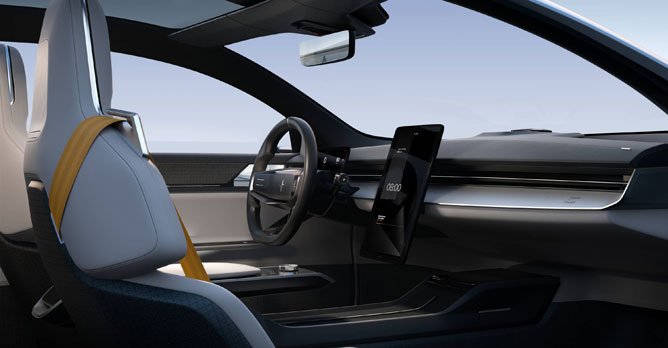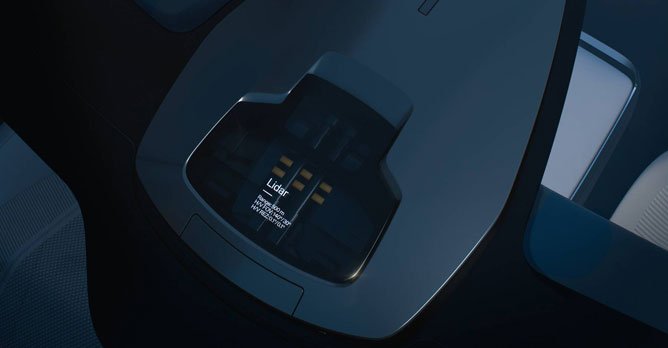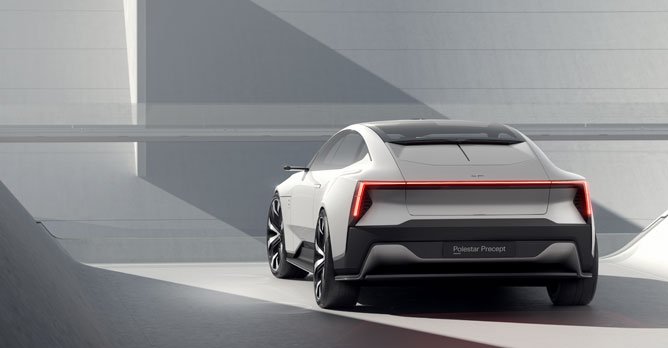Polestar unveils the Precept Concept
27 Feb 2020|1,021 views
Polestar has revealed the Polestar Precept - a vision of the brand's future direction and a clear expression of intent. The Precept exhibits the execution of new, more sustainable interior materials, the continued development of the digital user interface, and the essence of Polestar design.
The name 'Precept' was chosen to emphasise the vehicle's role in setting out Polestar's intent as the contemporary electric performance brand.
The car signifies an important milestone for Polestar as a standalone brand, describing a unique design philosophy that remains firmly embedded in Polestar's brand values - pure, progressive and performance.
The sculpted form of the Polestar Precept will set the tone for future Polestar vehicles.
The vehicle's proportions define its presence with restrained surfacing and a focus on aerodynamic efficiency. A 3,100mm wheelbase accommodates a large battery pack and gives the stunning four-door grand tourer a very low and sleek silhouette, with an emphasis on leg and headroom in the rear.
The front grille is replaced by the 'Polestar SmartZone' - an area that once channelled air to radiators and the internal combustion engine now houses technology for safety sensors and driver assistance functions, representing a shift from breathing to seeing.
Purposefully gathered behind a transparent panel dedicated to intelligent hardware are two radar sensors and a high definition camera.
The Light Detection and Ranging (LIDAR) pod, mounted atop the glass roof, is given optimal visibility as a next step towards increased driving assistance. Meanwhile, the 'Thor's Hammer' LED head light signature has evolved with separated elements, taking on a dynamic, more robotic and brand-defining interpretation.
At the rear, the wide light-blade spans the entire width of the car, extending into vertical aero-wings - another aerodynamic feature and a nod to lightweight design.
Conventional side mirrors are replaced by camera-based units on the concept, each of which extends outwards on an aerodynamic arm. Inside, the traditional rear-view mirror is replaced with a digital screen, the image collected by a wide-angle camera mounted at the rear of the car. The Precept's single-volume glass roof extends behind the rear seats, and the tailgate itself is designed for a larger opening with higher-mounted hinges improving access.

Seat surfaces are 3D-knitted from recycled polyethylene bottles, bolsters and headrests are made from recycled cork vinyl, while carpets are made from reclaimed fishing nets. These elements, combined with digital artistry, define a new premium luxury that surpasses the conventions of leather, wood and chrome.
The next generation Human Machine Interface, powered by Android, builds on Polestar's close collaboration with Google. An enlarged, portrait-oriented 15.0-inch centre touch screen complements a 12.5-inch driver display, and the two are linked by an illuminated blade that encompasses the entire interior. In this execution, the unique Polestar emblem floats holographically inside a solid piece of Swedish crystal between the rear seat headrests.
Supporting the advancement of a personalised and dynamic digital interface, the instrument panel also hosts an array of smart sensors. Eye tracking will allow the car to monitor the driver's gaze and adjust the content of the various screens accordingly. Proximity sensors also enhance the usability of the centre display when driving.
Polestar will present the Precept concept at the Geneva International Motor Show from 5 to 15 March 2020.
Polestar has revealed the Polestar Precept - a vision of the brand's future direction and a clear expression of intent. The Precept exhibits the execution of new, more sustainable interior materials, the continued development of the digital user interface, and the essence of Polestar design.
The name 'Precept' was chosen to emphasise the vehicle's role in setting out Polestar's intent as the contemporary electric performance brand.
The car signifies an important milestone for Polestar as a standalone brand, describing a unique design philosophy that remains firmly embedded in Polestar's brand values - pure, progressive and performance.
The sculpted form of the Polestar Precept will set the tone for future Polestar vehicles.
The vehicle's proportions define its presence with restrained surfacing and a focus on aerodynamic efficiency. A 3,100mm wheelbase accommodates a large battery pack and gives the stunning four-door grand tourer a very low and sleek silhouette, with an emphasis on leg and headroom in the rear.
The front grille is replaced by the 'Polestar SmartZone' - an area that once channelled air to radiators and the internal combustion engine now houses technology for safety sensors and driver assistance functions, representing a shift from breathing to seeing.
Purposefully gathered behind a transparent panel dedicated to intelligent hardware are two radar sensors and a high definition camera.
The Light Detection and Ranging (LIDAR) pod, mounted atop the glass roof, is given optimal visibility as a next step towards increased driving assistance. Meanwhile, the 'Thor's Hammer' LED head light signature has evolved with separated elements, taking on a dynamic, more robotic and brand-defining interpretation.
At the rear, the wide light-blade spans the entire width of the car, extending into vertical aero-wings - another aerodynamic feature and a nod to lightweight design.
Conventional side mirrors are replaced by camera-based units on the concept, each of which extends outwards on an aerodynamic arm. Inside, the traditional rear-view mirror is replaced with a digital screen, the image collected by a wide-angle camera mounted at the rear of the car. The Precept's single-volume glass roof extends behind the rear seats, and the tailgate itself is designed for a larger opening with higher-mounted hinges improving access.

Seat surfaces are 3D-knitted from recycled polyethylene bottles, bolsters and headrests are made from recycled cork vinyl, while carpets are made from reclaimed fishing nets. These elements, combined with digital artistry, define a new premium luxury that surpasses the conventions of leather, wood and chrome.
The next generation Human Machine Interface, powered by Android, builds on Polestar's close collaboration with Google. An enlarged, portrait-oriented 15.0-inch centre touch screen complements a 12.5-inch driver display, and the two are linked by an illuminated blade that encompasses the entire interior. In this execution, the unique Polestar emblem floats holographically inside a solid piece of Swedish crystal between the rear seat headrests.
Supporting the advancement of a personalised and dynamic digital interface, the instrument panel also hosts an array of smart sensors. Eye tracking will allow the car to monitor the driver's gaze and adjust the content of the various screens accordingly. Proximity sensors also enhance the usability of the centre display when driving.
Polestar will present the Precept concept at the Geneva International Motor Show from 5 to 15 March 2020.
Latest COE Prices
August 2025 | 2nd BIDDING
NEXT TENDER: 03 Sep 2025
CAT A$104,524
CAT B$124,400
CAT C$72,190
CAT E$125,001
View Full Results Thank You For Your Subscription.





























